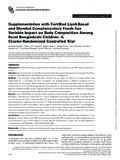| dc.contributor.author | Shaikh, Saijuddin | |
| dc.contributor.author | Campbell, Rebecca K | |
| dc.contributor.author | Mehra, Sucheta | |
| dc.contributor.author | Kabir, Alamgir | |
| dc.contributor.author | Schulze, Kerry J | |
| dc.contributor.author | Wu, Lee | |
| dc.contributor.author | Ali, Hasmot | |
| dc.contributor.author | Shamim, Abu Ahmed | |
| dc.contributor.author | West, Keith P | |
| dc.contributor.author | Christian, Parul | |
| dc.date.accessioned | 2022-05-10T06:39:55Z | |
| dc.date.available | 2022-05-10T06:39:55Z | |
| dc.date.copyright | 2020 | |
| dc.date.issued | 2020-04-02 | |
| dc.identifier.citation | Shaikh, S., Campbell, R. K., Mehra, S., Kabir, A., Schulze, K. J., Wu, L., . . . Christian, P. (2020). Supplementation with fortified lipid-based and blended complementary foods has variable impact on body composition among rural Bangladeshi children: A cluster-randomized controlled trial. Journal of Nutrition, 150(7), 1924-1932. doi:10.1093/jn/nxaa061 | en_US |
| dc.identifier.uri | http://hdl.handle.net/10361/16586 | |
| dc.description | This article was published in the Journal of Nutrition by Oxford Academic [ Copyright C The Author(s) on behalf of the American Society for Nutrition 2020. This is an Open Access article distributed under the terms of the Creative
Commons Attribution License (http://creativecommons.org/licenses/by/4.0/),] and the definite version is available at: https://doi.org/10.1093/jn/nxaa061 The Journal's website is at: https://academic.oup.com/jn/article/150/7/1924/5815134 | en_US |
| dc.description.abstract | Background: Complementary food supplementation enhances linear growth and may affect body composition in
children.
Objective: We aimed to determine the effect of complementary food supplements provided from the age of 6 to 18 mo
on fat-free mass (FFM) and fat mass (FM) gain among children in rural Bangladesh.
Methods: In an unblinded, cluster-randomized, controlled trial we tested the effects of 4 complementary food
supplements for 1 y [chickpea, rice lentil, Plumpy’doz, and wheat-soy-blend++ (WSB++)] compared with no
supplements on linear growth. Body composition was estimated using weight-length-based, age- and sex-specific
equations at 6, 9, 12, 15, and 18 mo and postintervention aged 24 mo. Generalized estimating equations (GEEs) were
applied to estimate the effect of each complementary food on mean FFM and FM from 9 to 18 and 24 mo compared
with the control, adjusting for baseline measures. Sex interactions were also explored.
Results: In total, 3592 (65.9% of enrolled) children completed all anthropometric assessments. Estimated FFM and
FM (mean ± SD) were 5.3 ± 0.6 kg and 1.4 ± 0.4 kg, respectively, at the age of 6 mo. Mean ± SE FFM and FM
from 9 to 18 mo were 75.4 ± 14.0 g and 32.9 ± 7.1 g, and 61.0 ± 16.6 g and 30.0 ± 8.4 g, higher with Plumpy’doz
and chickpea foods, respectively, than the control (P < 0.001). Estimated FFM was 41.5 ± 16.6 g higher in rice-lentil-fed
versus control (P < 0.05) children. WSB++ had no impact on FFM or FM. A group-sex interaction (P < 0.1) was apparent
with Plumpy’doz and rice-lentil foods, with girls involved in the intervention having higher estimated FFM and FM than
control girls compared with no significant effect in boys. At 24 mo, FFM and FM remained higher only in girls eating
Plumpy’doz compared with the controls (P < 0.01).
Conclusions: In this randomized trial, supplementation effected small shifts in apparent body composition in rural
Bangladeshi children. Where seen, FFM increments were twice that of FM, in proportion to these compartments, and
more pronounced in girls. FFM increased in line with reported improvements in length. This trial was registered at
clinicaltrials.gov as NCT01562379. J Nutr 2020;150:1924–1932. | en_US |
| dc.language.iso | en_US | en_US |
| dc.publisher | Oxford Academic | en_US |
| dc.relation.uri | https://academic.oup.com/jn/article/150/7/1924/5815134 | |
| dc.subject | Childhood | en_US |
| dc.subject | Complementary feeding | en_US |
| dc.subject | Fat-free mass | en_US |
| dc.subject | Fat mass | en_US |
| dc.subject | Bangladesh | en_US |
| dc.title | Supplementation with fortified lipid-based and blended complementary foods has variable impact on body composition among Rural Bangladeshi children: A cluster-randomized controlled trial | en_US |
| dc.type | Journal Article | en_US |
| dc.description.version | Published | |
| dc.contributor.department | Brac James P. Grant School of Public Health | |
| dc.identifier.doi | https://doi.org/10.1093/jn/nxaa061 | |
| dc.relation.journal | Journal of Nutrition | |

